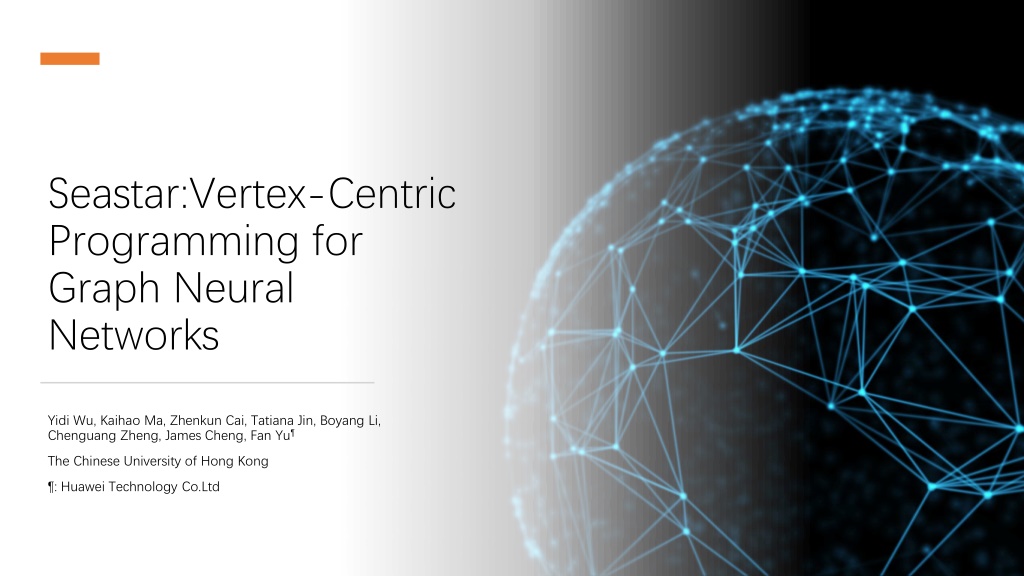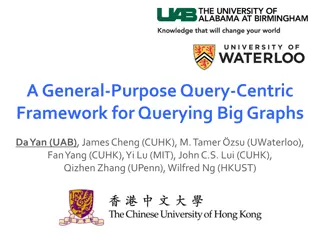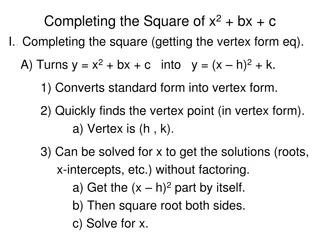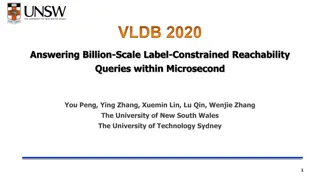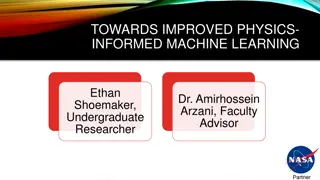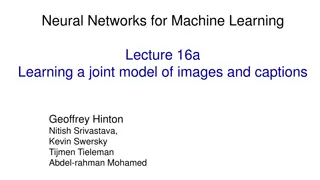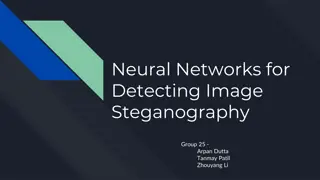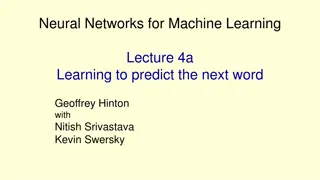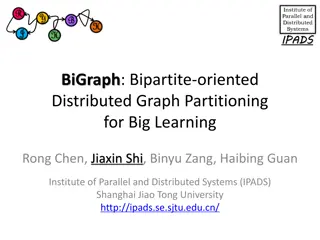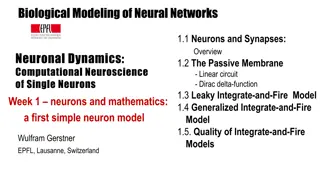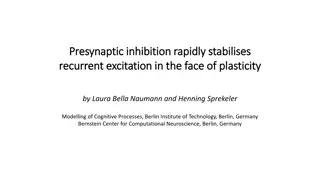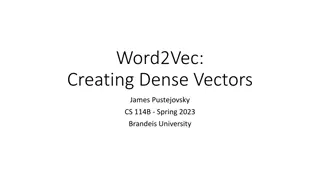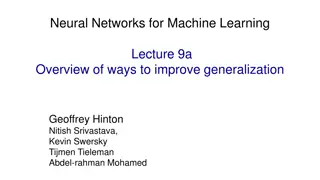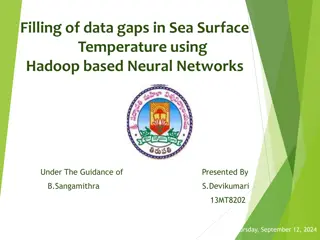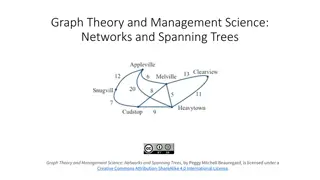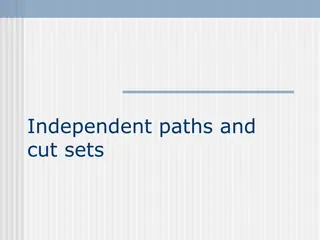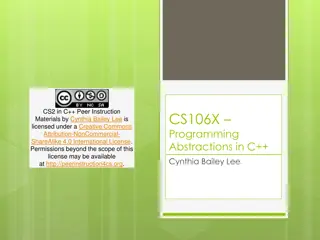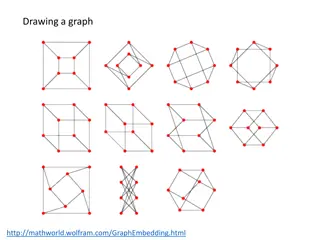Vertex-Centric Programming for Graph Neural Networks
Seastar presents a vertex-centric programming approach for Graph Neural Networks, showcasing better performance in graph analytic tasks compared to traditional methods. The research introduces the SEAStar computation pattern and discusses GNN programming abstractions, execution, and limitations. Deep Graph Library (DGL) and other frameworks like PyTorch Geometric (PyG) and NeuGraph are explored for organizing GNN computations efficiently.
- Graph Neural Networks
- GNN Programming
- Vertex-Centric Approach
- Deep Graph Library
- SEAStar Computation
Download Presentation

Please find below an Image/Link to download the presentation.
The content on the website is provided AS IS for your information and personal use only. It may not be sold, licensed, or shared on other websites without obtaining consent from the author. Download presentation by click this link. If you encounter any issues during the download, it is possible that the publisher has removed the file from their server.
E N D
Presentation Transcript
Seastar:Vertex-Centric Programming for Graph Neural Networks Yidi Wu, Kaihao Ma, Zhenkun Cai, Tatiana Jin, Boyang Li, Chenguang Zheng, James Cheng, Fan Yu The Chinese University of Hong Kong : Huawei Technology Co.Ltd
Graph Neural Networks Better performance in many graph analytic tasks than traditional methods Figure 1: Node classification on Cora (left) and link prediction on fb15k-237 (right) leaderboard [1] [1]: from https://paperswithcode.com/area/graphs
SEAStar Computation Pattern h2 Source h3 Edge sum h 1 h1 h4 Aggregation Figure 2: Vertex-centric view of GCN [1](top) and GAT [2] (bottom) [1]: Thomas N. Kipf, Max Welling. Semi-Supervised Classification with Graph Convolutional Networks. [2]: Petar Velickovic, Guillem Cucurull, Arantxa Casanova, Adriana Romero, Pietro Li , Yoshua Bengio. Graph Attention Networks
GNN Programming Abstractions Deep Graph Library (DGL) Provides the Graph abstraction Vertices feature vectors are grouped into tensor then stored in the graph Graph.update_all(func.copy_u( x , m ), func.sum( m , h )) func.copy_u creates a message tensor m by copying feature from vertex tensor x . func.sum reduces the message tensor m according to the destination and names the output h (a vertex tensor) PyTorchGeometric (PyG), NeuGraph Organize GNN computation into stages of tensor-wise operations PyG: message, update NeuGraph: Scatter-ApplyEdge-Gather-ApplyVertex (SAGA) GraphLearn, Euler Provide sampling APIs (e.g., GraphLearn s Gremlin-like API), no GNN specific abstraction for expressing GNN computation Rely on operations of DL frameworks only, e.g., tf.gather, tf.segment_sum
GNN Execution Tensor materialization: Within each stage, use operators of backend DL systems (e.g., matmul, leakyRelu) to carry out computation Across stages, Scatter/Gather operations are inserted (either by the framework or by users) to prepare the required input for next stage Source Edge Aggregation GSpMM optimization in DGL: Compute messages by add/sub/mul/div source node and edge features or copy node features to edges Aggregate the messages by sum/max/min/mean as the features on destination node
Limitations Programming Abstraction: Though expressive enough, users have to cast vertex-centric pattern into whole-graph and coarse-grained tensor program learn a set of low-level tensor operations (e.g., in GraphLearn and Euler) or domain specific APIs (e.g., in DGL, PyG and NeuGraph) Execution: Tensor materialization causes high memory consumption frequent data movements across GPU memory hierarchy GSpMM optimization only covers a limited set of operator combinations and delivers unsatisfying performance
Seastar Vertex-centric programming model that enables users to program and learn GNN models easily Dynamically generate and compile fast and efficient kernels for the vertex-centric UDF
Vertex-Centric Programming Model h2 h3 def gcn(v : CenterVertex): return sum([u.h for u in v.innbs()]) sum h 1 h1 h4 def gat(v : CenterVertex): E = [exp(leakyRelu(u.h + v.h)) for u in v.innbs()] Alpha = [e/sum(E) for e in E] return avg([u.h * a for u, a in zip(v.innbs(), Alpha)]) Vertex-Centric View of GCN and GAT Vertex-Centric Implementation of GCN and GAT
Seastar Code Generation operator overloading 2. Verify the correctness of user program 1. Record forward computational graph with Retrieve the backward computational graph with auto-differentiation Generate efficient CUDA kernels with execution template Optimize the computational graph of both forward and backward passes
def gat(v : CenterVertex): E = [exp(leakyRelu(u.h + v.h)) for u in v.innbs()] Alpha = [c/sum(E) for e in E] return sum([h * a for v.h, a in zip(v.innbs(), Alpha)]) Example: GAT Div AggSum Mul AggSum LeakyRelu Add Exp Div AggSum Mul AggSum LeakyRelu Add Exp Computational Graph of GAT Annotated with Graph Type Div AggSum Mul AggSum LeakyRelu Add Exp E-type Tensor A-type Fused Op Fused Computational Graph of GAT
Example: GAT Backward Graph Mul AggSum Div AggSum Mul Div Mul Mul Add Mul AggSum Mul Div Mul Add BackwardLeakyRelu D-type E-type Tensor A-type Fused Op
Fused Kernel Execution Dynamic Block Scheduling: Launch as many thread blocks as needed to cover al vertices. Pros: 1. Less load skew than static assignment; 2. Reduce overhead of explicit scheduling (e.g., using atomics). CUDA threads Thread Block-1 (256 threads) FAT-1 (16 threads) FAT-2 (16 threads) FAT: Feature Adaptive Threads group. Pro: Group size changes according to the dimensionality of feature vector to exploit feature-wise parallelism. V1 V2 Vertex-parallelism: Exploiting the locality of destination feature. Pros: 1. Can avoid aggregation conflict; 2. Destination feature only needs to be load/write once. Con: skewed load for power-law graphs Visit Sequentially Visit Sequentially
Vertex Degree Sorting Graph structure is fixed (for full-graph training) or is independent across mini-batch (in the case of sampling-based training) We can sort the vertices in descending order of in-degree in the background Benefits: We can avoid high-degree vertices become the straggler by assigning early launched blocks to vertices in the front computation of high-degree vertices can be overlapped with that of low-degree ones Reducing intra-block load imbalance (when the feature size is small) since consecutive vertices have similar degrees
Evaluation Less memory consumption especially for complex model training on large graphs Up to 14 times speed-up compared with DGL and up to 3 times compared with PyG By exploiting operator fusion opportunities and high- performance kernel design
Benchmarking the time of fetching all neighbor's feature for all vertices. Only show the speed up against baseline: Baseline: DGL s edge-parallel design Basic: Vertex-parallel with static FAT size 256 FA+Unsorted: Change the FAT size according to feature size FA+Sorting+Atomic: Sort the vertices and use atomic instructions to assign vertices to thread block FA+Sorting+Dynamic: Seastar s complete design Up to 946 times faster than baseline FAT and Sorting significantly improve the performance when the feature size is small Evaluation
Summarize Better usability with vertex-centric programming Better performance by applying compilation optimizations from
